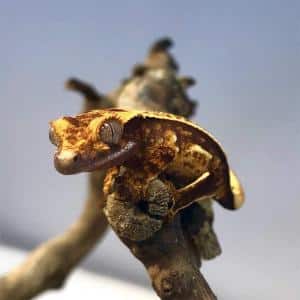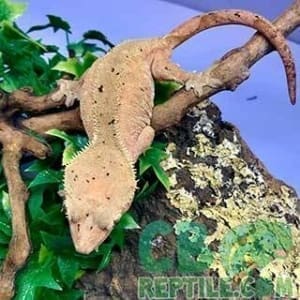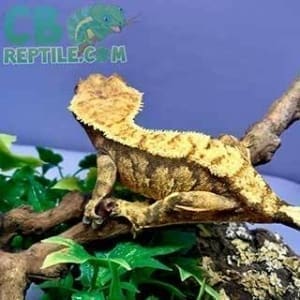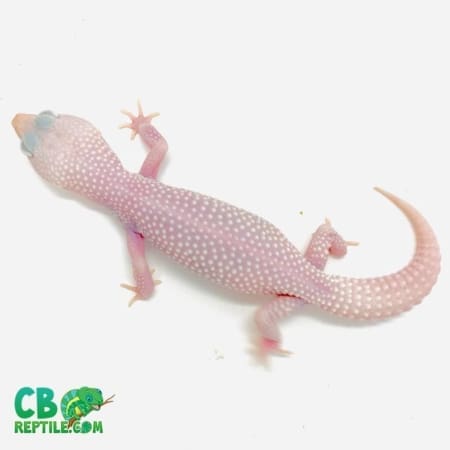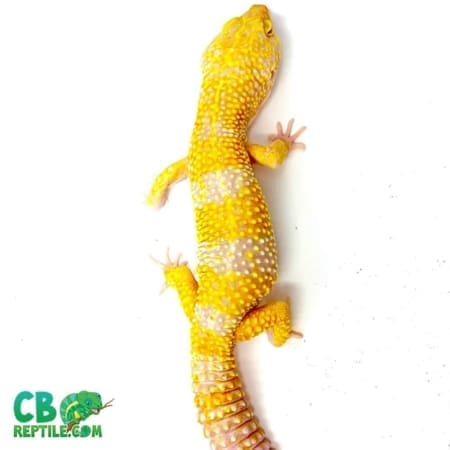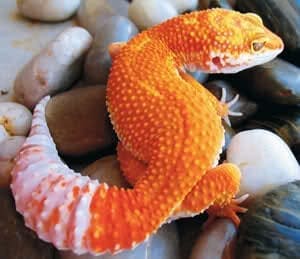Baby Crested Gecko Shedding:
So your new baby gecko is shedding and your concerned. Don’t be! It is normal and part of growing that your baby crested gecko will shed approximately once per month. Eating the shed is also normal, so when you see that, just relax and know that your gecko is normal!
Should I be concerned with my crested gecko shedding?
Shedding is nothing to worry about, so long as you are misting the enclosure and the relative humidity in the enclosure is maintained at 65-75%. Secondly, after a misting the cresties should be rehydrated and shed with ease.
Crested Gecko Care Sheet
The biologist here at CB Reptile has provided an in-depth crested gecko care guide including many different care related topics. Explore our full care sheet for specific sections here:
- Crested gecko care sheet
- baby crested geckos
- crested gecko heating
- crested gecko lighting
- baby crested gecko diet
- crested gecko supplements
- crested gecko for sale
- best crested gecko humidity
- crested gecko habitat
- baby crested gecko temperature
- crested gecko size
- crested gecko lifespan
- baby crested gecko habitat maintenance
- crested gecko breeders
- crested gecko shedding
- how to pick up a crested gecko
Crested gecko Heating and Lighting:
One of the nice things about crested geckos is they do not really require any UVB lighting. It is totally optional and may just be for viewing purposes only. Crested Geckos do not really require low levels of UVB lighting for 10-12 hours of the day but some breeders still use it.
This is totally optional as most crested gecko breeders and keepers do not provide lighting. Keep in mind, this should be between 3-5% UVB, and types of recommend UVB lamps or bulbs would be an Arcadia 5% range bulb or the Reptisun 5.0 lamp. Heat lamps are not really required unless your house or area you have your habitat in is not at room temp. Crested geckos prefer 72-75 degrees. If your home is too cold, or too hot, you may need to supplement the heat or cold with a heat mat, heat lamp, or air conditioner. Cresties cannot be housed above 80 degrees.
Crested Gecko Temperature:
Crested geckos will survive being kept at room temperature in captivity (72) however the best temps for health is 74 degrees. The optimum temperature range is between 68-77 degrees F, we prefer to keep ours at around 73-74F. Too much heat is not good for cresties! It is important to note that if the high temperature eclipses 80 degrees, crested geckos do not fare well. Long term exposure to temperatures that exceed 80 degrees will end up causing the crestie to eventually die. For this reason, consider it being too hot, as important or critical to it being too cold. Most keepers that are new to crested geckos do not realize this!
Crested Geckos Habitat Maintenance:
Every day, you should allow yourself 5 minutes to clean your maintain your crested gecko habitat. On a day to day basis we quickly change the water so it is fresh in crested gecko enclosures. Also, with a mister, we will do a light spray of water round the enclosure either once or twice per day. This allows the enclosure to remain humid for the crested geckos to shed properly as they grow. Lastly, we try our best to spot clean any visible waste such or uneaten food and replace it with fresh crested gecko diet.
Baby Crested Gecko Diet – Crested Gecko Feeding:
Like most reptiles, pet Crested geckos for sale are omnivorous meaning they will eat a variety of different things. In the wild crested geckos primarly feed on insects, nectar and rotting fruit. For this reason, we need to cater for their dietary requirements as best we can in our home habitats that we create. Here at CB, we feed both live insects and Pangea crested gecko diet (which is a crested gecko powdered food you make up using water. This type of food is used to replace the fruit as well as the nectar that cresties would consume in the wild. Lastly, we dust and use crickets as a feeder insect as they are active at the same time as the geckos (in the evenings).
Crested gecko feeding routines
Basically, as a rule of thumb, we always keep fresh pangea gecko diet in with our cresties. We change the food completely, using throw away plastic food cups, every two days (or 2.5 times per week). The same goes for water. Change your geckos water at least 2-3 times per week. If you are keeping food and water together on the same gecko feeding ledge, expect to have to change the water everyday!
Baby Crested Gecko Supplements:
We recommend supplementing every insect feed by dusting the insects with a calcium with d3 and reptile vitamin mixture. Usually we just dust everything that we feed our geckos. Using a high quality crested gecko diet, like Pangea or Repashy will ensure they are getting adequate vitamins and minerals when eating their food. If you are using T5 High output UVB lighting, use calci dust or another similar calcium supplement without vitamin d3 in it as you will not need both.
Crested Gecko Activity Pattern:
Many people refer to crested geckos as being nocturnal but that is not accurate! Cresties are actually crepuscular. What does that mean? They’re most active at dusk and dawn, however, they are also active throughout the nighttime.
Crested gecko humidity
Humidity is very important for basically all species of pet geckos. Cresteds are no different. By keeping humidity in the proper range, you will help your crested gecko stay hydrated, and shed properly. Shedding is a big part of a growing baby crested gecko, and without proper humidity can be a problem.
If humidity is too low (air is too try) your baby gecko will have trouble shedding. For this reason we recommend using a reptile fogger and hydrometer to be sure you are keeping your humidity around 70%. 70% is the recommended humidity when keeping any morph or color of crested gecko. By providing the right humidity, your baby crested gecko will enjoy a much happier life!
Why is my baby crested gecko eating its’ shed skink?
What is my crestie eating? Do not be alarmed, crested geckos, like most other geckos may eat their shed skin. For this reason, you may not notice that they have shed unless you catch them in the act. Always be sure to check out the tips of their toes. Toes as well as the tail and round the head can sometimes have stuck shed that you may need to help remove.
Crested Gecko Size & Growth:
With proper care, habitat, maintenance, supplements crested geckos grow to full size rather quickly. Typically they reach 6-7″ including tail, and 40-50 grams of overall weight once 12-18 months old. At this stage, they are considered young adults. Babies are 0 to 6 months, juveniles 6 to 17 months, etc. Cresties are reasonably light weight, smaller species of pet gecko for sale.
Crested Gecko Habitat and Crested Gecko Terrarium Cleaning:
We recommend cleaning your crested gecko habitat fully once a month. Spot cleaning may be done as often as possible. Using water or a reptile safe cleaning solution is recommended. For a substrate with our crested gecko breeder groups, we use paper towels. While paper towels may not look the best, they are certainly a sanitary option, that are easy to clean or change. Alternative types of substrate like reptile carpet work but will need to be cleaned weekly and replaced monthly to prevent odor.
baby Crested Gecko Handling:
If you are patient, Crested geckos are great for handling and can become quite tame. While all are different, patience is key to getting your baby crested gecko to trust your handling. Remember, cresties can drop their tail if they are scared, handled roughly. or if their tail is pinched or pulled. Having a prehensile tail (they can grip with it) does help them grab and hang from branches, so they are typically reluctant to drop it unless very frightened. Newly hatched baby crested geckos are at risk of dropping their tails until they settle down which takes a few days.
Crested Gecko Breeding:
If correctly cared for crested geckos are one of the easiest species of pet geckos to breed. We recommend waiting until male crested geckos are 15-16 months and females 18-20 months old to breed. They should usually weigh around 45 grams or larger for females, 42 grams or larger for males. Once they reach the proper weight, they normally breed themselves without any special additional consideration. Always make sure that there is at least 4 inches of damp substrate (we use reptile soil and cocoa coir) in the base of the enclosure. You can use a tupperware container with a 2″ hole cut in it as a lay box.
Gravid females need a lay box with damp substrate
If gravid (with eggs) the female crested geckos will deposit their eggs in the lay box, usually about 2.5″ deep in the substrate. Because the substrate is so important for both shedding, and egg laying, it is recommended to spray it down every other week. Spray more or less often as needed, depending on the humidity of the habitat. If the habitat is too dry you may need to supplement the humidity or lack thereof with additional spraying.
They lay 2 eggs once per month for approximately 6-7 months of the year usually starting in the spring. The eggs need to be incubated in damp vermiculite at 24-27C for the best chance of them hatching in approximately 8-10 weeks. During breeding season monitor the weight of your females and make sure they do not drop below 80% of their pre-breeding season weight. If they lose more than 15-20% of their weigh then separate them from the male to reduce further egg production.
Once mated at the beginning of the season they are able to retain sperm and lay fertile eggs for the duration of the season so even when separated from the male they may still produce a couple more clutches of eggs. Eggs production slows down from around 7-8 years of age but it is unclear whether they undergo breeding cessation in old age like their close relative the New Caledonian Giant gecko.
Crested Gecko Health Complications:
If you have followed the advice in our crested gecko care sheet and purchased from us here at CB Reptile, than you shouldn’t have any need for this section as crested geckos are one of the hardiest and healthiest geckos in in the pet gecko realm. Unfortunately, some of the more frequently encountered problems revolve around lack of calcium and vitamin D3 thru poor diets.
Crested geckos and MBD (metabolic bone disease)
MBD is caused by a lack of dietary calcium or insufficient calcium reserves in egg laying female crested geckos more so then males. MBD is experienced by geckos that are not fed a well balanced diet, or just insects that are not gut loaded or fed a dusted diet of insects. If caught on time, an increased level of calcium in the diet (like adding liquid calcium to the water dish) can sometimes help treat and clear up mild cases. If MBD is left untreated, the will continue to break down and decline until it ultimately passes away.
MBD in any pet reptile leads to the bones becoming weak causing conditions such as bendy leg (exactly what it sounds like) and rubber jaw . While these conditions are easily preventable and curable in the early stages, advanced cases are hard to treat and often lead to putting the animal down. There is no reason to ever experience MBD if you follow proper gecko care guidelines.
Tips and Tricks:
-
Fruit Puree/ baby food is often recommended but with the artificial diets now available there are considerably better options so I would recommend using these rather than baby food.
- You can mix a little honey into the Pangea or Repashy crested gecko food / diet if you find they are reluctant to eat it.
- Dubia roaches and wax worms can make a great alternative live food as a treat.
- remove water marks from the glass in the crested gecko terrarium or habitat, the safest thing to use is 50:50 water and white vinegar. Spray it onto the glass and wipe off with a paper towel or damp cloth.
- baby crested geckos for sale take around 2 weeks to settle in once arriving home.
-

black night leopard gecko
$949.00 – $1,695.00Price range: $949.00 through $1,695.00 Sale!Select options This product has multiple variants. The options may be chosen on the product page -

Striped Emerine Leopard gecko
$299.95 – $849.00Price range: $299.95 through $849.00 Sale!Select options This product has multiple variants. The options may be chosen on the product page -
 Rated 5.00 out of 5
Rated 5.00 out of 5Diablo Blanco Leopard gecko for sale
$169.95 – $759.00Price range: $169.95 through $759.00 Sale!Select options This product has multiple variants. The options may be chosen on the product page -

Tangerine Albino supergiant leopard gecko
$269.95 – $749.00Price range: $269.95 through $749.00 Sale!Select options This product has multiple variants. The options may be chosen on the product page -
 Rated 5.00 out of 5
Rated 5.00 out of 5Tangerine Super Giant Leopard gecko
$299.95 – $695.00Price range: $299.95 through $695.00 Sale!Select options This product has multiple variants. The options may be chosen on the product page -

Tangelo leopard gecko
$179.00 – $689.00Price range: $179.00 through $689.00 Sale!Select options This product has multiple variants. The options may be chosen on the product page -

Blood het Tremper Albino Leopard gecko
$199.95 – $649.00Price range: $199.95 through $649.00 Sale!Select options This product has multiple variants. The options may be chosen on the product page -

Tangerine Albino leopard gecko
$169.00 – $599.00Price range: $169.00 through $599.00 Sale!Select options This product has multiple variants. The options may be chosen on the product page -

Aptor Leopard gecko
$149.95 – $599.00Price range: $149.95 through $599.00 Sale!Select options This product has multiple variants. The options may be chosen on the product page -

Blood leopard gecko
$199.00 – $599.00Price range: $199.00 through $599.00 Sale!Select options This product has multiple variants. The options may be chosen on the product page -

blood supergiant leopard gecko
$269.95 – $599.00Price range: $269.95 through $599.00 Sale!Select options This product has multiple variants. The options may be chosen on the product page -

Firewater Blood cross Leopard gecko
$159.95 – $599.00Price range: $159.95 through $599.00 Sale!Select options This product has multiple variants. The options may be chosen on the product page -

Firewater Leopard gecko
$179.95 – $599.00Price range: $179.95 through $599.00 Sale!Select options This product has multiple variants. The options may be chosen on the product page -

blood purple head leopard gecko
$169.00 – $589.00Price range: $169.00 through $589.00 Sale!Select options This product has multiple variants. The options may be chosen on the product page -

Bold Super Giant Leopard gecko
$259.95 – $569.00Price range: $259.95 through $569.00 Sale!Select options This product has multiple variants. The options may be chosen on the product page -

Blazing Blizzard Leopard gecko
$169.00 – $549.00Price range: $169.00 through $549.00 Sale!Select options This product has multiple variants. The options may be chosen on the product page -
 Rated 4.88 out of 5
Rated 4.88 out of 5Mack Super Snow Leopard gecko for sale
$169.00 – $549.00Price range: $169.00 through $549.00 Sale!Select options This product has multiple variants. The options may be chosen on the product page -
 Rated 5.00 out of 5
Rated 5.00 out of 5Mandarin Tangerine Leopard gecko
$199.00 – $499.00Price range: $199.00 through $499.00 Sale!Select options This product has multiple variants. The options may be chosen on the product page -

Electric Tangerine Leopard gecko
$189.95 – $499.00Price range: $189.95 through $499.00 Sale!Select options This product has multiple variants. The options may be chosen on the product page -
 Rated 5.00 out of 5
Rated 5.00 out of 5Bold Leopard gecko for sale
$149.95 – $499.00Price range: $149.95 through $499.00 Sale!Select options This product has multiple variants. The options may be chosen on the product page


